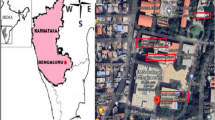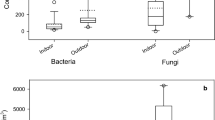Abstract
The concentrations of bacterial and fungal bioaerosols were measured in a retirement home and a school dormitory from May 2012 to May 2013. In the present work, two active and passive methods were used for bioaerosol sampling. The results from the present work indicated that Bacillus spp., Micrococcus spp., and Staphylococcus spp. were the dominant bacterial genera, while the major fungal genera were Penicillium spp., Cladosporium spp., and Aspergillus spp. The results also indicated that the indoor-to-outdoor (I/O) ratios for total bacteria were 1.77 and 1.44 in the retirement home and the school dormitory, respectively; the corresponding values for total fungal spores were 1.23 and 1.08. The results suggested that in addition to outdoor sources, indoor sources also played a significant role in emitting bacterial and fungal bioaerosols in the retirement home and the school dormitory indoor.



Similar content being viewed by others
References
Abdel Hameed A, Khoder M, Yuosra S, Osman A, Ghanem S (2009) Diurnal distribution of airborne bacteria and fungi in the atmosphere of Helwan area, Egypt. Sci Total Environ 407:6217–6222
Agranovski I (2011): Aerosols: science and technology. John Wiley & Sons
Asefa DT, Langsrud S, Gjerde RO, Kure CF, Sidhu MS, Nesbakken T, Skaar I (2009) The performance of SAS-super-180 air sampler and settle plates for assessing viable fungal particles in the air of dry-cured meat production facility. Food Control 20:997–1001
Aydogdu H, Asan A, Otkun MT (2010) Indoor and outdoor airborne bacteria in child day-care centers in Edirne City (Turkey), seasonal distribution and influence of meteorological factors. Environ Monit Assess 164:53–66
Burch M, Levetin E (2002) Effects of meteorological conditions on spore plumes. Int J Biometeorol 46:107–117
Després VR, Huffman JA, Burrows SM, Hoose C, Safatov AS, Buryak G, Fröhlich-Nowoisky J, Elbert W, Andreae MO, Pöschl U (2012): Primary biological aerosol particles in the atmosphere: a review. Tellus B 64
DMU-FOLU GG, Hantel M, Philander S, Schneider S (2004): Atmospheric and oceanographic sciences library
Fang Z, Ouyang Z, Hu L, Wang X, Zheng H, Lin X (2005) Culturable airborne fungi in outdoor environments in Beijing, China. Sci Total Environ 350:47–58
Fang Z, Ouyang Z, Zheng H, Wang X, Hu L (2007) Culturable airborne bacteria in outdoor environments in Beijing, China. Microb Ecol 54:487–496
Fang Z, Gong C, Ouyang Z, Liu P, Sun L, Wang X (2014) Characteristic and concentration distribution of culturable airborne bacteria in residential environments in Beijing, China. Aerosol Air Qual Res 14:943–953
Gniadek A, Macura AB, Oksiejczuk E, Krajewska-Kułak E, Łukaszuk C (2005) Fungi in the air of selected social welfare homes in the Małopolskie and Podlaskie provinces—a comparative study. Int Biodeterior Biodegrad 55:85–91
Godwin C, Batterman S (2007) Indoor air quality in Michigan schools. Indoor Air 17:109–121
Guida M, Gallé F, Di Onofrio V, Nastro R, Battista M, Liguori R, Battista F, Liguori G (2012) Environmental microbial contamination in dental setting: a local experience. J Prev Med Hyg 53:207–212
Hoseini M, Jabbari H, Naddafi K, Nabizadeh R, Rahbar M, Yunesian M, Jaafari J (2013) Concentration and distribution characteristics of airborne fungi in indoor and outdoor air of Tehran subway stations. Aerobiologia 29:355–363
Hsu Y-C, Kung P-Y, Wu T-N, Shen Y-H (2012) Characterization of indoor-air bioaerosols in Southern Taiwan. AAQR 12:651–661
Jo W-K, Seo Y-J (2005) Indoor and outdoor bioaerosol levels at recreation facilities, elementary schools, and homes. Chemosphere 61:1570–1579
Jones AM, Harrison RM (2004) The effects of meteorological factors on atmospheric bioaerosol concentrations—a review. Sci Total Environ 326:151–180
Kalwasińska A, Burkowska A, Wilk I (2012) Microbial air contamination in indoor environment of a university library. Ann Agric Environ Med: AAEM 19:25–29
Kim KY, Kim CN (2007) Airborne microbiological characteristics in public buildings of Korea. Build Environ 42:2188–2196
Kim K-Y, Kim H-T, Kim D, Nakajima J, Higuchi T (2009) Distribution characteristics of airborne bacteria and fungi in the feedstuff-manufacturing factories. J Hazard Mater 169:1054–1060
Kim KY, Kim YS, Kim D, Kim HT (2011) Exposure level and distribution characteristics of airborne bacteria and fungi in Seoul metropolitan subway stations. Ind Health 49:242–248
Kowalski W (2005): Aerobiological engineering handbook: airborne disease and control technologies. McGraw Hill Professional
Lee J-H, Jo W-K (2006) Characteristics of indoor and outdoor bioaerosols at Korean high-rise apartment buildings. Environ Res 101:11–17
Mentese S, Arisoy M, Rad AY, Güllü G (2009) Bacteria and fungi levels in various indoor and outdoor environments in Ankara, Turkey. Clean Soil Air Water 37:487–493
Mentese S, Rad AY, Arısoy M, Güllü G (2012a) Multiple comparisons of organic, microbial, and fine particulate pollutants in typical indoor environments: diurnal and seasonal variations. J Air Waste Manage Assoc 62:1380–1393
Mentese S, Rad AY, Arısoy M, Güllü G (2012b) Seasonal and spatial variations of bioaerosols in indoor urban environments, Ankara, Turkey. Indoor Built Environ 21:797–810
Naddafi K, Jabbari H, Hoseini M, Nabizade R, Rahbar M, Yunesian M (2011): Investigation of indoor and outdoor air bacterial density in Tehran subway system. Iran J Environ Health Sci Eng (IJEHSE)
Napoli C (2012) Prevention of healthcare-associated infections: which sampling method should be used to evaluate air bio-contamination in operating rooms. Epidemiol 2:e106
Napoli C, Marcotrigiano V, Montagna MT (2012a) Air sampling procedures to evaluate microbial contamination: a comparison between active and passive methods in operating theatres. BMC Public Health 12:594
Napoli C, Tafuri S, Montenegro L, Cassano M, Notarnicola A, Lattarulo S, Montagna M, Moretti B (2012b) Air sampling methods to evaluate microbial contamination in operating theatres: results of a comparative study in an orthopaedics department. J Hosp Infect 80:128–132
Nasir ZA, Colbeck I (2010) Assessment of bacterial and fungal aerosol in different residential settings. Water Air Soil Pollut 211:367–377
Nasir ZA, Colbeck I, Sultan S, Ahmed S (2012) Bioaerosols in residential micro-environments in low income countries: a case study from Pakistan. Environ Pollut 168:15–22
Pasquarella C, Pitzurra O, Savino A (2000) The index of microbial air contamination. J Hosp Infect 46:241–256
Pasquarella C, Veronesi L, Castiglia P, Liguori G, Montagna MT, Napoli C, Rizzetto R, Torre I, Masia MD, Di Onofrio V (2010) Italian multicentre study on microbial environmental contamination in dental clinics: a pilot study. Sci Total Environ 408:4045–4051
Pastuszka JS, Kyaw Tha Paw U, Lis DO, Wlazło A, Ulfig K (2000) Bacterial and fungal aerosol in indoor environment in Upper Silesia, Poland. Atmos Environ 34:3833–3842
Reboux G, Bellanger A, Roussel S, Grenouillet F, Sornin S, Piarroux R, Dalphin J, Millon L (2009) Indoor mold concentration in Eastern France. Indoor Air 19:446–453
Ruzer LS, Harley NH (2012): Aerosols handbook: measurement, dosimetry, and health effects. CRC Press
Scaltriti S, Cencetti S, Rovesti S, Marchesi I, Bargellini A, Borella P (2007) Risk factors for particulate and microbial contamination of air in operating theatres. J Hosp Infect 66:320–326
Scheff PA, Paulius VK, Curtis L, Conroy LM (2000) Indoor air quality in a middle school, part II: development of emission factors for particulate matter and bioaerosols. Appl Occup Environ Hyg 15:835–842
Srikanth P, Sudharsanam S, Steinberg R (2008) Bio-aerosols in indoor environment: composition, health effects and analysis. Indian J Med Microbiol 26:302
Wang W, Ma Y, Ma X, Wu F, Ma X, An L, Feng H (2010a) Seasonal variations of airborne bacteria in the Mogao Grottoes, Dunhuang, China. Int Biodeterior Biodegrad 64:309–315
Wang Y-F, Wang C-H, Hsu K-L (2010b) Size and seasonal distributions of airborne bioaerosols in commuting trains. Atmos Environ 44:4331–4338
Acknowledgments
This work was funded by the Institute for Environmental Research (IER) of Tehran University of Medical Sciences (grant number 90-03-46-18903).
Author information
Authors and Affiliations
Corresponding author
Additional information
Responsible editor: Philippe Garrigues
Sasan Faridi and Mohammad Sadegh Hassanvand are coequal first author contributors.
Rights and permissions
About this article
Cite this article
Faridi, S., Hassanvand, M.S., Naddafi, K. et al. Indoor/outdoor relationships of bioaerosol concentrations in a retirement home and a school dormitory. Environ Sci Pollut Res 22, 8190–8200 (2015). https://doi.org/10.1007/s11356-014-3944-y
Received:
Accepted:
Published:
Issue Date:
DOI: https://doi.org/10.1007/s11356-014-3944-y




